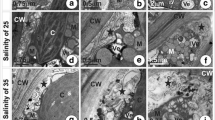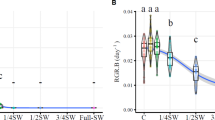Abstract
Salt is a limiting factor of plant growth in natural environments. Although not commonly exposed to salt, epiphytic orchids have some drought-related phenotypical traits that could grant some tolerance to the ionic component of salinity. Epidendrum fulgens Brongn. is a terrestrial orchid with recent epiphytic ancestry and it shares many phenotypic traits with epiphytic orchids. Here we investigated the salinity response of the orchid species E. fulgens by exposing plant stems to varying concentrations of artificial seawater spray (0, 200, 400 and 800 mM Na+). Each plant had four stems, each stem corresponding to a salt treatment. We measured the maximum quantum efficiency of photosystem II (PSII) over 10 days and at the end of this period, we measured the relative water content (RWC), osmotic potential, chlorophyll index, and leaf Na+ concentration. Negative effects of salt were only observed above 400 mM Na+. While stems treated with 800 mM Na+ reduced the osmotic potential, the RWC remained similar to control stems. Unexpectedly, leaf Na+ concentration was similar for salt-treaded and control stems, suggesting that E. fulgens might be able to avoid the leaf absorption of this ion. Therefore, E. fulgens can tolerate salt spray in similar concentrations as the seawater and some of its physiological responses, such as maintaining a high RWC when facing osmotic stress, resemble the response of epiphytic orchids when facing drought stress.



Similar content being viewed by others
References
Abdullakasim S, Kongpaisan P, Thongjang P, Saradhuldhat P (2018) Physiological responses of potted Dendrobium orchid to salinity stress. Hortic Environ Biotechnol 59:491–498. https://doi.org/10.1007/s13580-018-0057-4
Ahmad I, Wainwright SJ (1976) Ecotype differences in leaf surface properties of Agrostis stolonifera from salt marsh, spray zone and inland habitats. New Phytol 76:361–366
Baker NR (2008) Chlorophyll fluorescence: a probe of photosynthesis in vivo. Annu Rev Plant Biol 59:89–113. https://doi.org/10.1146/annurev.arplant.59.032607.092759
Barrs HD, Weatherley PE (1962) A re-examination of the relative turgidity technique for estimating water deficits in leaves. Aust J Biol Sci 15:413–428
Bates D, Mächler M, Bolker B, Walker S (2015) Fitting linear mixed-effects models using {lme4}. J Stat Softw 67:1–48. https://doi.org/10.18637/jss.v067.i01
Benzing DH, Atwood JT Jr (1984) Orchidaceae: ancestral habitats and current status in forest canopies. Syst Bot 9:155–165
Brown RW, Oosterhuis DM (1992) Measuring plant and soil water potentials with thermocouple psychrometers: some concerns. Agron J 84:78–86
Cardoso-Gustavson P, Saka MN, Pessoa EM, Palma-Silva C, Pinheiro F (2018) Unidirectional transitions in nectar gain and loss suggest food deception is a stable evolutionary strategy in Epidendrum (Orchidaceae): insights from anatomical and molecular evidence. BMC Plant Biol 18:1–13. https://doi.org/10.1186/s12870-018-1398-y
Christenhusz MJM, Byng JW (2016) The number of known plants species in the world and its annual increase. Phytotaxa 261:201. https://doi.org/10.11646/phytotaxa.261.3.1
Cui YY, Pandey DM, Hahn EJ, Paek KY (2004) Effect of drought on physiological aspects of crassulacean acid metabolism in Doritaenopsis. Plant Sci 167:1219–1226. https://doi.org/10.1016/j.plantsci.2004.06.011
Dickson AG, Goyet C (1994) Handbook of methods for the analysis of the various parameters of the carbon dioxide system in sea water, 2nd edn. Oak Ridge National Lab, Oak Ridge
De La Rosa-Manzano E, Andrade JL, Zotz G, Reyes-García C (2014) Respuestas fisiológicas a la sequía, de cinco especies de orquídeas epífitas, en dos selvas secas de la península de Yucatán. Bot Sci 92:607–616
Du J, Hesp PA (2020) Salt spray distribution and its impact on vegetation zonation on coastal dunes: a review. Estuaries Coasts 43:1885–1907. https://doi.org/10.1007/s12237-020-00820-2
Fernández V, Bahamonde HA, Peguero-Pina JJ, Gil-Pelegrín E, Sancho-Knapik D, Gil L, Goldbach HE, Eichert T (2017) Physico-chemical properties of plant cuticles and their functional and ecological significance. J Exp Bot 68:5293–5306. https://doi.org/10.1093/jxb/erx302
Gantiva EAR, Díez MCG, Moreno FHH (2020) Efecto de la interacción luz-agua sobre la fotosíntesis de la Vanilla planifolia (Orchidaceae). Rev Biol Trop 68:1250–1261. https://doi.org/10.15517/rbt.v68i4.41385
Gotsch SG, Nadkarni N, Darby A, Glunk A, Dix M, Davidson K, Dawson TE (2015) Life in the treetops: ecophysiological strategies of canopy epiphytes in a tropical montane cloud forest. Ecol Monogr 85:393–412. https://doi.org/10.1890/14-1076.1
Gravendeel B, Smithson A, Slik FJW, Schuiteman A (2004) Epiphytism and pollinator specialization: drivers for orchid diversity? Philos Trans R Soc Lond B Biol Sci 359:1523–1535. https://doi.org/10.1098/rstb.2004.1529
Hietz P, Wagner K, Nunes Ramos F, Cabral JS, Agudelo C, Benavides AM, Cach-Pérez MJ et al (2022) Putting vascular epiphytes on the traits map. J Ecol 110:340–358. https://doi.org/10.1111/1365-2745.13802
Hörtensteiner S (2006) Chlorophyll degradation during senescence. Ann Rev Plant Biol 57:55–77. https://doi.org/10.1146/annurev.arplant.57.032905.105212
Hunter KAM, Wu L (2005) Morphological and physiological response of five California native grass species to moderate salt spray: implications for landscape irrigation with reclaimed water. J Plant Nutr 28:247–270. https://doi.org/10.1081/PLN-200047609
Karremans AP (2021) With great biodiversity comes great responsibility: the underestimated diversity of Epidendrum (Orchidaceae). Harv Pap Bot. https://doi.org/10.3100/hpib.v26iss2.2021.n1
Munné-Bosch S, Alegre L (2000) Changes in carotenoids, tocopherols and diterpenes during drought and recovery, and the biological significance of chlorophyll loss in Rosmarinus officinalis plants. Planta 210:925–931. https://doi.org/10.1007/s004250050699
Munns R (2002) Comparative physiology of salt and water stress. Plant Cell Environ 25:239–250. https://doi.org/10.1046/j.0016-8025.2001.00808.x
Munns R (2011) Plant adaptations to salt and water stress: differences and commonalities. Adv Bot Res 57:1–32. https://doi.org/10.1016/B978-0-12-387692-8.00001-1
Munns R, Tester M (2008) Mechanisms of salinity tolerance. Annu Rev Plant Biol 59:651–681. https://doi.org/10.1146/annurev.arplant.59.032607.092911
Ogburn RM, Edwards EJ (2010) The ecological water-use strategies of succulent plants. In: Kader JC, Delseny M (eds) Advances in botanical research, 1st edn. Elsevier, Amsterdam, pp 179–225
Pinheiro F, Koehler S, Corrêa AM, Salatino MLF, Salatino A, de Barros F (2009) Phylogenetic relationships and infrageneric classification of Epidendrum subgenus Amphiglottium (Laeliinae, Orchidaceae). Plant Syst Evol 283:165–177. https://doi.org/10.1007/s00606-009-0224-2
Pinheiro F, de Barros F, Palma-Silva C, Fay MF, Lexer C, Cozzolino S (2011) Phylogeography and genetic differentiation along the distributional range of the orchid Epidendrum fulgens: a neotropical coastal species not restricted to glacial refugia. J Biogeog 38:1923–1935
R Core Team (2022) R: a language and environment for statistical computing. R Foundation for Statistical Computing, Vienna
Santos CV (2004) Regulation of chlorophyll biosynthesis and degradation by salt stress in sunflower leaves. Sci Hortic 103:93–99. https://doi.org/10.1016/j.scienta.2004.04.009
Schreel JDM, Steppe K (2020) Foliar water uptake in trees: negligible or necessary? Trends Plant Sci 25:590–603
Stancato GC, Buckeridge MS, Mazzafera P (2001) Effect of a drought period on the mobilisation of non-structural carbohydrates, photosynthetic efficiency and water status in an epiphytic orchid. Plant Physiol Biochem 39:1009–1016. https://doi.org/10.1016/S0981-9428(01)01321-3
Wu H (2018) Plant salt tolerance and Na+ sensing and transport. Crop J 6:215–225
Xie X, He Z, Chen N, Tang Z, Wang Q, Cai Y (2019) The roles of environmental factors in regulation of oxidative stress in plant. BioMed Res Int. https://doi.org/10.1155/2019/9732325
Zasoski RJ, Burau RG (1977) A rapid nitric-perchloric acid digestion method for multi‐element tissue analysis. Commun Soil Sci Plant Anal 8:425–436
Zhang S, Yang Y, Li J, Qin J, Zhang W, Huang W, Hu H (2018) Physiological diversity of orchids. Plant Divers 40:196–208. https://doi.org/10.1016/j.pld.2018.06.003
Zotz G, Hietz P (2001) The physiological ecology of vascular epiphytes: current knowledge, open questions. J Exp Bot 52:2067–2078. https://doi.org/10.1093/jexbot/52.364.2067
Zotz G, Tyree MT (1996) Water stress in the epiphytic orchid Dimerandra emarginata (G. Meyer) hoehne. Oecologia 107:151–159. https://doi.org/10.1007/BF00327898
Acknowledgements
Support for this work was provided by the Higher Education Funding Council Wales (HEFCW) and Global Challenges Research Fund (GCRF) fellowship FE36. T.M.L. acknowledges both the National Council for Scientific and Technological Development (CNPq, Brazil, #131720/2020-1) and the São Paulo Research Foundation (FAPESP, Brazil, grant #2020/12723-0) for the scholarships granted. S.F.S. also acknowledges FAPESP for the scholarship granted (Grant # 2015/14817-4). R.V.R. is a fellow of the National Council for Scientific and Technological Development (CNPq, Brazil). We are also grateful to Prof. Eduardo Arcoverde (IB/UFRJ, in memoriam) and Dr. Ingrid Koch (IB/UNICAMP) for their comments in the early versions of this research project.
Funding
This study was funded by Fundação de Amparo à Pesquisa do Estado de São Paulo (2020/12723-0, 2015/14817-4), Conselho Nacional de Desenvolvimento Científico e Tecnológico (131720/2020-1), Higher Education Funding Council for Wales, Global Challenges Research Fund (FE36).
Author information
Authors and Affiliations
Corresponding author
Ethics declarations
Conflict of interest
The authors declare there is no known conflict of interest regarding the publication of this article.
Additional information
Publisher’s Note
Springer Nature remains neutral with regard to jurisdictional claims in published maps and institutional affiliations.
Rights and permissions
Springer Nature or its licensor (e.g. a society or other partner) holds exclusive rights to this article under a publishing agreement with the author(s) or other rightsholder(s); author self-archiving of the accepted manuscript version of this article is solely governed by the terms of such publishing agreement and applicable law.
About this article
Cite this article
de Lima, T.M., da Silva, S.F., Ribeiro, R.V. et al. Short-term salt spray reveals high salt tolerance in a neotropical orchid species. Theor. Exp. Plant Physiol. 35, 355–362 (2023). https://doi.org/10.1007/s40626-023-00291-3
Received:
Accepted:
Published:
Issue Date:
DOI: https://doi.org/10.1007/s40626-023-00291-3




